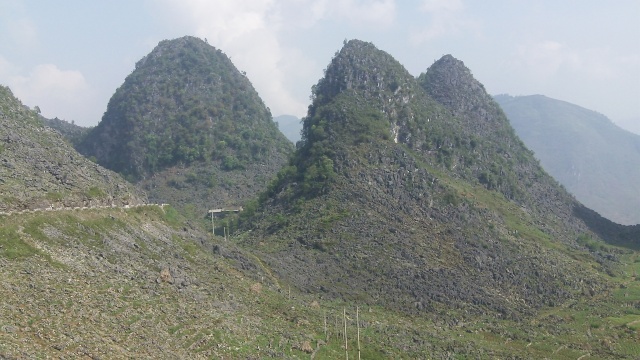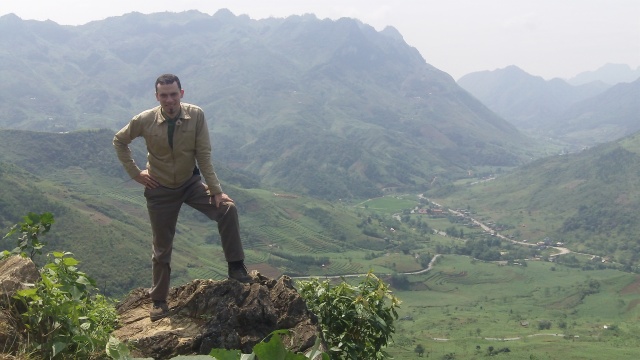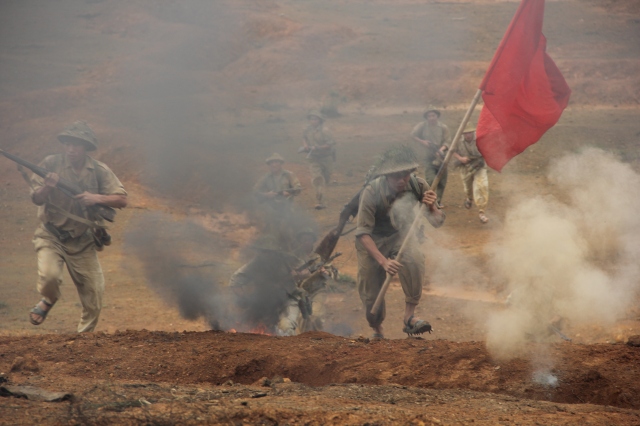Three hundred yards down the road, my travel companions were waiting. “Is everything OK?” Dean asked me. Smiling I said, “Oh, you should have seen me – no problems whatsoever. Apparently, he just wanted to check my driver’s license.” We crossed the valley, and then up another pass. This pass was unlike the others; the biome changed from the dense subtropical foliage to a dry pine forest. It looked more like Colorado than Vietnam.

I kept thinking of that song, “Rocky mountain high in Colorado. . .” This didn’t look like tropical Vietnam.
After an hour of pressing my bike down the tight switchbacks, I reached the bottom – and stopped for lunch. Twenty minutes later, Dean and Natalie pulled up. “Do you think we should get our permits now?” Dean mused. “Yea, we should have done that in Ha Giang City, but we should definitely get them now.” I told him. Ha Giang Province is an area that has a frontier with China, so foreigners are supposed to get a permit. We went to the local police station. Twenty minutes and a few dollars later, we had our ‘hall pass’, nicely printed on a yellow card. “We need to call ahead to Dong Van and reserve a room,” Natalie told us, “The hotels are going to be packed.” Getting out her smart phone and connecting to the wireless signal, she called a few places and finally reserved a room for us all.
Driving out of yet another valley, we climbed again into scenery that changed again. The limestone slopes became covered in jagged talus; it seemed as if it was from a film-set for a fantasy production. “When’s Gandalf gonna show up?” I thought to myself. It was a wild landscape, but every pocket of soil between the boulders was cultivated by highland peoples dressed in their tribal costumes.

The road took a turn and clawed up the side of a gorge with a river about 200 meters below the road. Ahead there was a small crowd of people, looking over the precipice. It was obvious what had happened. As I walked up to the precipice I could see a twisted motorcycle at the bottom of the ravine. “Someone fell?” Natalie said. “Yea, apparently he didn’t even touch the side on the way down.” I commented. Three men were at the scene; having moved his body to the side, they were standing over the bike and going through his identity papers. Natalie listened to the conversation, “They say he was probably drunk and lost control.” “Well if he was drunk,” I said, “he really picked the wrong road to drive on, because there ain’t much room for error.” Dean wasn’t convinced, “People always say that when someone crashes. A bus probably came around a corner too fast and knocked him off.” It was a real sobering thought: one moment of inattention and . . . but there was nothing to be done, so we drove on.
Despite the unpleasant stop, we drove up and up through jagged moonscapes, until we entered the clouds and crossed another pass. I checked my altimeter watch; it was about 5,000 feet – the highest pass I’ve ever crossed in Vietnam. We were now close to our destination – Dong Van, and it was downhill. Several kilometers later, we rounded a corner, and there it was; a small town in a flat valley with steep mountains around. The skies had been sunny; but the rain came it torrents as soon as we reached the valley floor. Perfect timing.
Drenched, we rolled up to our hotel, only to discover they had given our room away to someone else. Thanks! So we drove to a traditional inn. It was one of the oldest buildings in town: with a courtyard, tiled roof, stone flagging, carved wood balustrades and massive wooden gates – it was like a tavern from a Kung Fu film set, where’s Jet Li when you need him? They had a room available; and in good ‘traditional style’ the room was: a windowless nook with a rock-hard bed. That’s something they never tell you in all those Kung Fu films. Since other tourists were setting up sleeping bags in the town square, we took the room.
Thursday, after a flee-bitten night, we decided to go to the northernmost point of Vietnam – Lung Cu. This was another drive on winding roads, through jagged mounds of disfigured rock with pocket-sized crop fields. It took us about an hour to reach the destination, a massive tower perched on a knoll. “Do you think we should go to the top?” said Dean. “I guess so, perhaps we can get a good view of the Chinese border,” I told him.

A hot climb up a massive stair case brings you to the northernmost tip of Vietnam. I can see Kunming from here!
The climb to the top was a shade-less eternity of steps – I thought my knees would burst. The monument at the top was the usual concrete massif with plaques and murals – but no protection from the burning sun for the crowds. The scenic views were rewarding, but fifteen minutes on the glaring concrete was enough. I told Dean, “I don’t know if my knees will handle all those stairs on the descent.” “Go down the road, it will be easier.” Natalie told me. So I began to walk down the road, but was picked up by a motorcyclist – awesome.
By the time we returned to Dong Van, it was late afternoon. It was still sunny, but the air had cooled. “I think Nat and I will go up there.” Dean said, pointing to what looked like a castle on the top of a cliff. “Sounds good,” I told him, “I’ll go up in a little while.” Twenty minutes later I found the trail around the back of the cliff to the top. It was not a castle, but a French fort most likely built a century earlier. There wasn’t much left: a curtain wall clung to the precipice, a few trenches, and two circular emplacements for mortars or light artillery. “Oh hi.” said Natalie, after I found them at one of the emplacements. “Nice view, isn’t it?” Dean commented. “Yea, you can see how a small howitzer placed here would command the entire valley.” I told him. As the sun set, we went back to town. This time we stayed at a slightly better hotel, translation: we had a shower and no flees in the beds.

This little fort sits precariously on a cliff a few hundred meters above Dong Van. There isn’t much room for anything up here.
Friday morning was cool and sunny; we were able to get a fairly early start heading east to Meo Vac, and then south to Bao Lac. As soon as we left for Meo Vac we were surrounded by the most amazing mountain scenery of the entire trip. The road slithered like a sable ribbon through the sharp peaks covered in shattered rock; far below rivers wound through narrow choked valleys. I kept stopping to take pictures, and eventually Dean said, “Come on Caleb, we can’t stop at every spot for pictures.” “Yea, I know,” I told him, “but this is the best mountain scenery I’ve ever encountered in Vietnam.”
We turned south down a smaller valley, and reached Meo Vac. From there we were supposed to head to Bao Lac, but somehow missed it all-together in our descent. It was hot now, and we drove along the bottom of a narrow valley. For some reason, it was anticlimactic. For me driving up into the mountains is euphoric, but coming down out of them is disappointing. Maybe it’s the heat.
By the late afternoon we had reached the town of Bac Me and were a little unsure of how much further to go. “Nat and I need to be back in Ha Giang City before 10:30AM tomorrow,” Dean told me, “so we can catch the bus to Hanoi.” I encouraged him to not go further, “We are about three hours away from Ha Giang, but you won’t be able to reach it before nightfall. Poor mountain roads at night are a bad idea.” We decided to stay in Bac Me, and they would leave early the next morning.
We found a nice hotel, took a quick rest, and then drove out into the fields in the waning light. We parked near a river; it was a perfectly pastoral scene. Steep hills, rice fields, a flowing stream; people were washing clothes by the bridge; a woman was herding ducks, two young girls sat nearby tending a few water buffalo. As usual, Dean took to the rice paddies – sinking to his shins in the warm mud; I decided to try the creek instead. “Hey Nat,” Dean said with a slight smile, “Why don’t you go up and pet that water buffalo?” She wasn’t interested, “No way.” I looked at the girls; they treated it like a pet dog. “I’m sure it’s safe, she’s probably used to being around people,” I said while casually striding toward the animal. I got within fifteen feet; the cow looked up, stopped chewing and stared at me while breathing heavily through her wet nose. That reaction, coupled with the two-foot-long horns stopped me in my tracks. I said to the girl in Vietnamese, “That cow doesn’t like me, does she?” The girl looked back with a smile, “That’s right, she doesn’t.” Internet videos of people being tossed into the air by buffaloes danced through my head. I walked away and the slab of meat went back to grazing.
It was raining on Saturday morning, the days of clear weather were over and I had at least three hours of driving to reach Ha Giang City, the other two had left earlier. I planned to reach the city at lunch, stay the night, and drive back to Hanoi on Sunday. The road was rough, and the hilly country would have been beautiful minus the fog and rain. I hit road construction –this meant a kilometer of mud and about 200 meters of deep muddy truck ruts so terrifying, that at three different times I thought the bike was going to dump me into the goo.

The last few hours back to Ha Giang City was in this sort of weather. Unpleasant, not to mention the mud.
I crossed into Ha Giang City and the sun came out, it was only 10AM. It was still early, so I thought, “I may as well go to Tuyen Quang City today.” The road was dry, so I rocketed along – reaching my destination at about 3PM. “Hmmm, I’ve only got about four hours to go, I may as well go all the way home.” That was a mistake, because the last two hours of driving were a dark, dusty gauntlet of terrifying trucks. Thirteen hours and 370km after leaving Bac Me, I dragged myself into my apartment – miraculously unscathed.
Ha Giang was that mythical place I had heard about from a few hardier travelers. It was the place that had been just out of reach for nearly two years, but I had finally seen it. I’ve been to many mountainous areas in Vietnam like: Sa Pa, Mai Chau, Da Lat, Phong Nha, and A Luoi. Yet the stark beauty of the landscape, the vibrancy of the ethnic minorities, and the lack of foreign tourists made Ha Giang exceptional.
In conclusion I’d say: Ha Giang, it’s an amazing place of fairy tale topography and cultures that time forgot. My advice to all tourists that visit Vietnam . . . go to Sa Pa or go to Da Lat. Don’t go to Ha Giang – there’s nothing to see.
😉












































